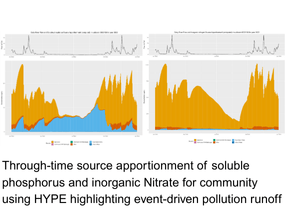Rising waters | Rooted solutions
Measuring what matters: choosing the right indicators for NFM success

Monitoring NFM impacts is crucial for securing investment and ensuring interventions are effective. That’s why we are working to establish a clear, evidence-based framework for monitoring NFM benefits
Natural flood management (NFM) provides multiple benefits, from reducing flood risk to improving biodiversity and water quality. But how do we measure its success?
Monitoring NFM impacts is crucial for securing investment and ensuring interventions are effective. However, inconsistent measurement approaches across projects make it difficult to prove NFM’s full value (as discussed in our recent blog on NFM monitoring). That’s why Ousewem is working to establish a clear, evidence-based framework for monitoring NFM benefits.
The challenge: inconsistent monitoring undermines investment
- NFM delivers a wide range of benefits, but there no way to measure them consistently.
- Different projects use different metrics, making it hard to compare results and build a strong business case for investment.
- Without robust evidence, funding decisions remain cautious, and NFM’s potential remains underutilised.
Building consensus: reviewing existing guidance;
At the NFM COP Monitoring Skill Share: Best Practices, Challenges and Hands-On Learning event on 11 April 2025, leading researchers and practitioners will explore how we can improve consistency in NFM monitoring (building on previous discussions about the multiple benefits of NFM.) A key focus will be the need for standardised indicators that capture both flood risk benefits and wider ecosystem services.

This approach builds on our modelling work to map pollution risks across the SUNO catchment, which helps refine how we measure the impact of nature-based solutions on water quality. By linking hydrological and pollution transport models, we can better understand how NFM reduce pollution, ensuring that water quality indicators are robust and effective. Read how Ousewem is mapping water quality, using modelling to improve our rivers.
Ousewem has been reviewing key monitoring guidance: the team at JBA is identifying methods for monitoring the benefits of NFM and identifying where current approaches are unable to monitor certain benefits. Our findings will help shape a practical, decision-making tool and guidance document for land managers, practitioners, funders, and policymakers.
What’s next? Refining indicators and preparing for the workshop
As we move forward, the Ousewem team are taking key steps to ensure that our monitoring indicators are practical, effective, and aligned with investment needs.
Here’s what’s happening next:
- Finalising a long list of potential indicators and metrics - The University of York has reviewed how NFM benefits have been measured in previous projects and research, identifying over 200 indicators and nearly 200 metrics.
- Categorising indicators - Researchers are organising these indicators into tables categorised by different NFM activities, and their potential benefits, e.g. biodiversity, water quality, flood risk reduction, carbon sequestration.
- Preparing for the stakeholder workshop (September 2025) - This event will bring together practitioners, policymakers, and funders to co-design a final list of indicators and metrics based on their credibility, meaningfulness, feasibility and communicability.
This work also connects to another key initiative - a willingness-to-pay survey. This survey, part of Ousewem’s wider research into NFM co-benefits, aims to understand how different stakeholders value the additional ecosystem services that NFM provides beyond flood risk reduction, such as:
- Nature and biodiversity - enhancing habitats and supporting wildlife.
- Human health and wellbeing - improving access to green spaces and reducing urban heat.
- Water quality - reducing pollution and sediment from rivers.
- Local climate regulation - increasing carbon sequestration and improving soil health.
To support this we are:
- Researching suitable indicators to ensure the willingness-to-pay survey reflects NFM’s full range of benefits.
- Developing a co-benefits review manuscript for publication, helping to improve our understanding of the available evidence, working towards NFM investment
By refining these indicators and engaging with stakeholders, we are taking a critical step toward establishing a shared monitoring framework that will support long-term investment in NFM.
Strengthening the case for investment - get involved
Alongside this work, Ousewem is also exploring funding mechanisms for NFM. The team are producing an interim report on existing funding options and are planning interviews with key stakeholders, including project managers, and organisations with oversight of nature-based investment. These interviews will help shape future investment strategies for NFM.

To build a clearer picture of how NFM is currently funded - and how investment can be expanded - we are looking to speak with:
- Project managers involved in NFM or nature-based solutions (NbS).
- Fund manager and funding brokers working in green finance.
- Water companies, local authorities and infrastructure providers with an interest in flood resilience.
- National and local policy makers involved in environmental or climate funding.
If you or your organisation are involved in funding or delivering NbS and are willing to share your insights, we’d love to hear from you. Join us in shaping the future of NFM monitoring and build on our ongoing research into modelling and monitoring.
Get in touch to express your interest
Also see

